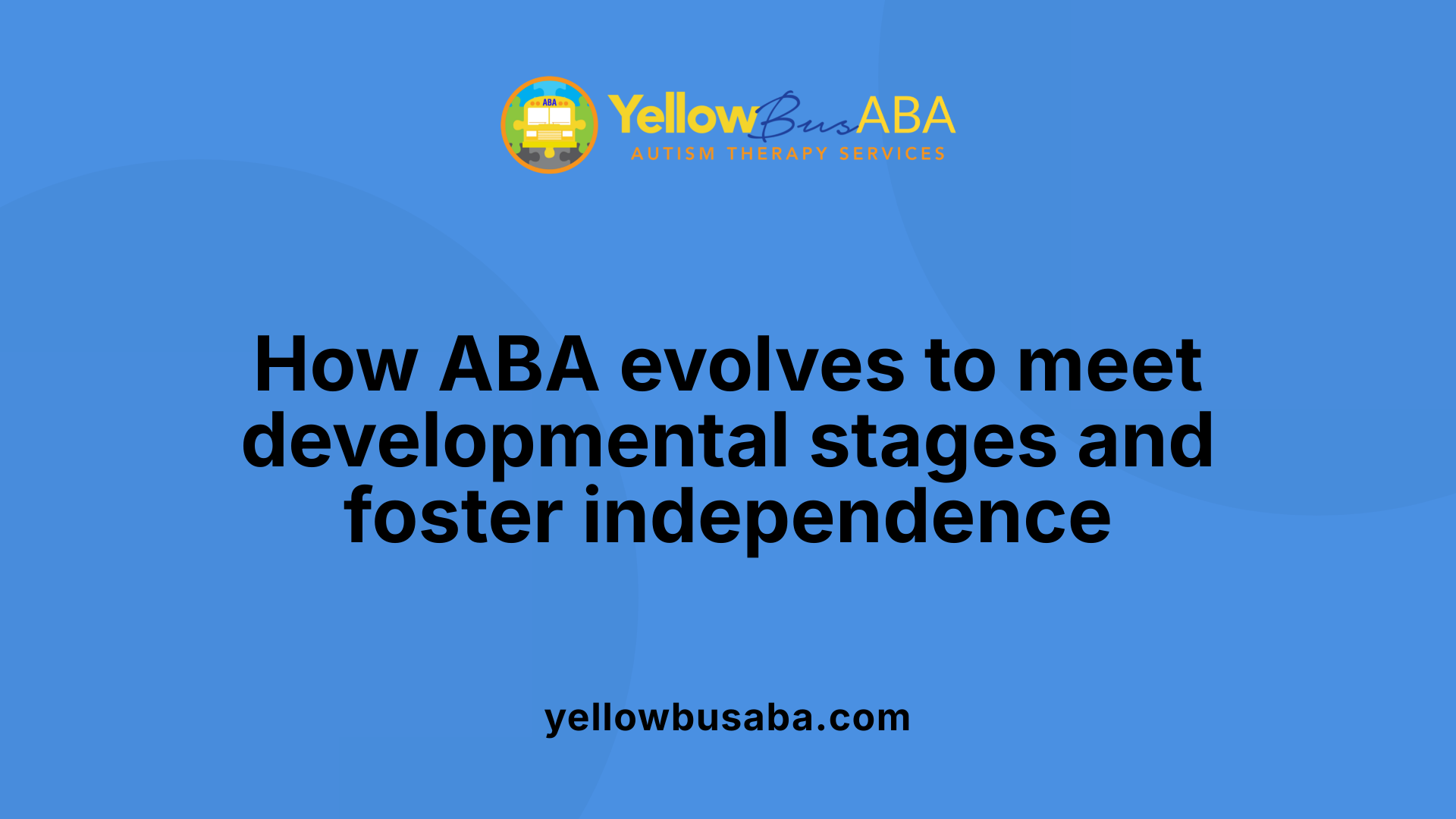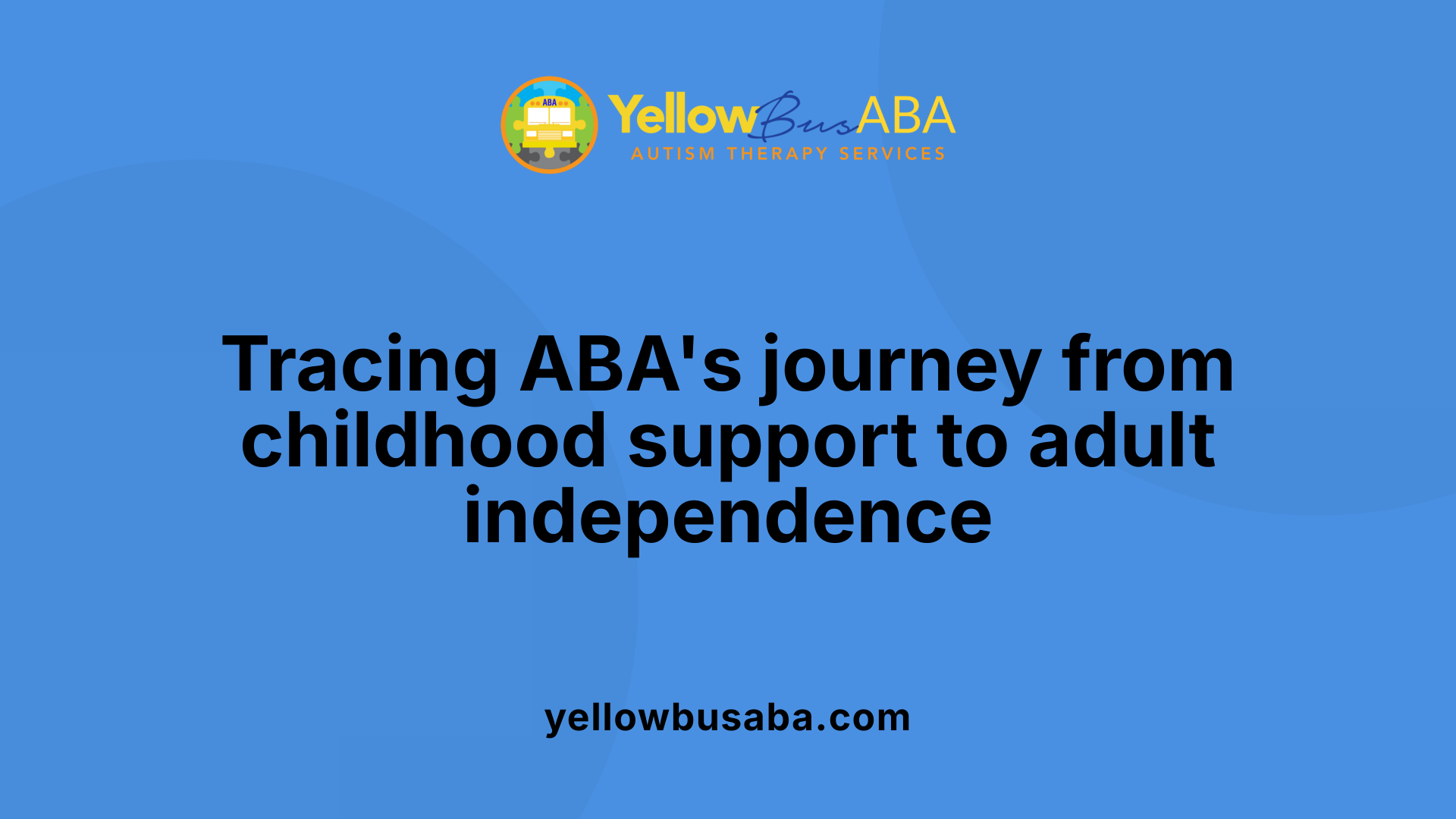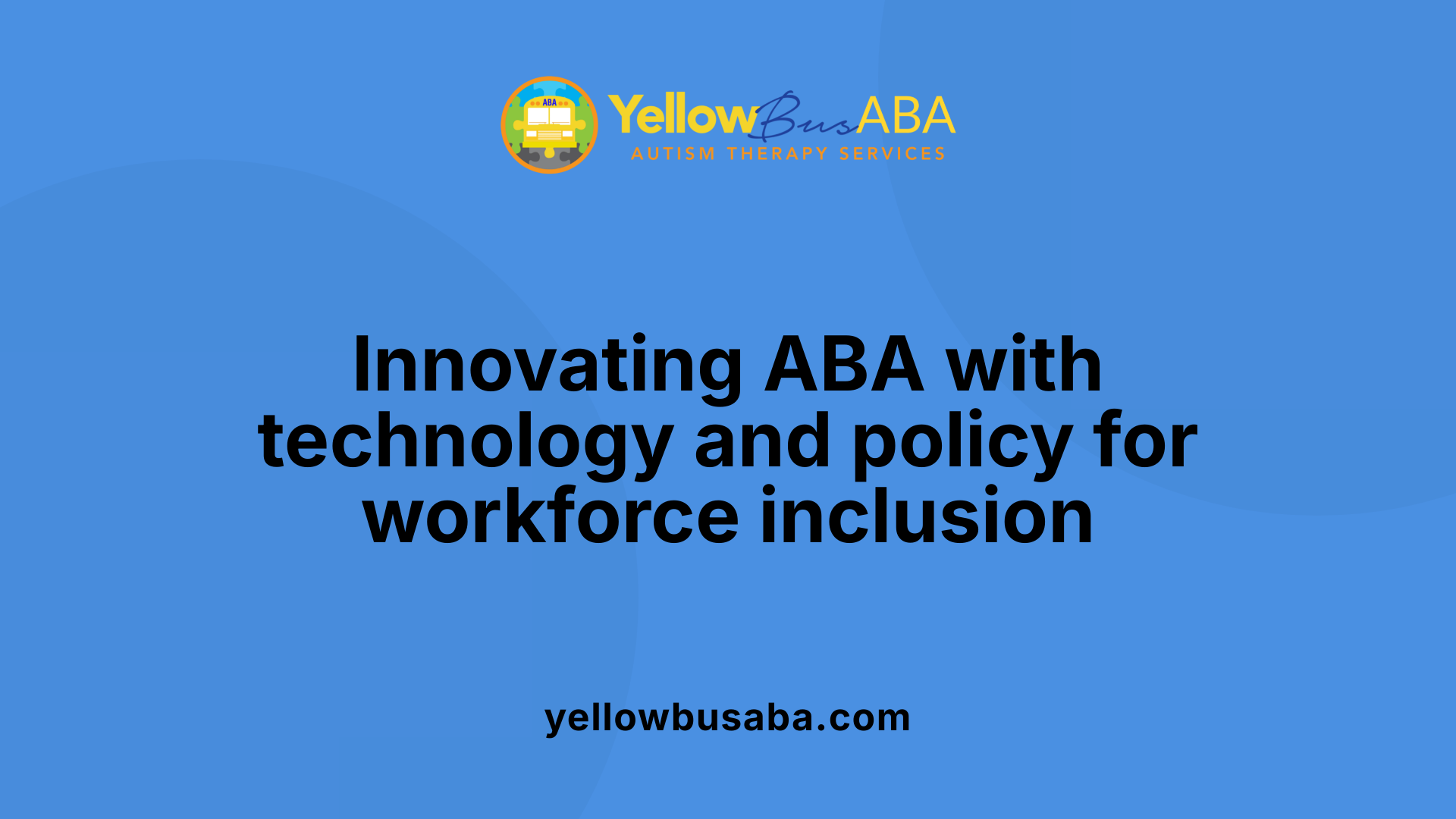How Young Adult ABA Therapy Prepares Individuals for the Workforce
July 24, 2025
Empowering Independence: The Role of ABA Therapy in Workforce Readiness for Young Adults with Autism

Preparing Young Adults with Autism for Successful Careers through Tailored Interventions
Applied Behavior Analysis (ABA) therapy has long been recognized as a cornerstone in supporting individuals with autism across various developmental stages. Its adaptability makes it particularly effective for young adults, a crucial period when transitioning from education to employment and independent living. This article explores how ABA therapy equips young adults with autism with the necessary skills, strategies, and confidence to thrive in the workforce, highlighting evidence of its success and the comprehensive approaches used to facilitate effective transitions into adult life.
Developmental Progression of ABA Therapy Across Age Groups

How does ABA therapy help young adults develop employment and independent living skills?
ABA therapy aids young adults in gaining crucial skills for independence and employment by employing customized, research-backed strategies. It teaches practical daily life skills such as personal care routines, meal planning, and budgeting. Additionally, it emphasizes vocational skills like effective communication, teamwork, and problem-solving through activities like role-playing and task analysis.
This therapy also focuses on enhancing social skills vital for community integration and workplace success. Skills such as interpreting social cues, adjusting communication styles, and building relationships are cultivated. Consistent assessment and data-driven precision ensure that these skills are acquired effectively and maintained over time.
Beyond therapy, collaboration with families and professionals ensures comprehensive transition plans supporting long-term independence and community participation.
The Evolution of ABA Therapy: From Early Childhood to Adulthood

How has ABA therapy historically focused on early childhood?
ABA therapy was originally developed to support young children, especially those diagnosed with autism, by targeting foundational skills. Starting typically before age 5, especially around 18 to 30 months, early intervention involves intensive, one-to-one sessions that focus on communication, social skills, and daily living tasks. Evidence shows that initiating therapy early, often for at least 15 hours weekly over two years, results in significant long-term improvements in IQ, adaptive functioning, and reduction of autism symptoms.
How has ABA expanded to include adolescents and young adults?
Over time, the scope of ABA has grown to serve older age groups, including school-aged children, teenagers, and even young adults. For adolescents, the focus shifts towards developing life skills, vocational readiness, and social confidence. Techniques are adapted to include real-life practice, such as mock interviews and group activities, to prepare for independence and employment.
For teenagers approaching adulthood, ABA emphasizes transitioning skills—like self-care, problem-solving, and emotional regulation—that support greater independence. It also helps foster social awareness and resilience needed for community engagement and employment participation.
How are goals and strategies adjusted for different age groups?
In preschoolers, ABA primarily uses play-based activities to build skills like following instructions and managing tantrums. For school-age children, interventions are tailored to incorporate academic readiness, social skills, and collaboration with educators. When working with teenagers, the therapy focuses more on practical life skills, managing anxiety, and developing vocational competencies.
This age-specific approach involves modifying strategies such as task analysis, reinforcement, prompting, and generalization across diverse environments. For adolescents and adults, ABA programs often involve real-world applications, including job simulations and social skills training in community settings.
Why is continuous adaptation important?
Adjusting ABA techniques to fit developmental stages ensures relevant skill development and maximizes outcomes. By addressing the changing needs of individuals with autism, ABA helps promote independence, social participation, and employment, easing the transition into adulthood.
| Age Group | Focus Areas | Techniques and Approaches | Outcomes |
|---|---|---|---|
| Young Children | Communication, social skills, routines | Play-based, prompting, reinforcement | Foundational skills, reduced autism symptoms |
| School-aged Children | Academic skills, social interaction, emotional regulation | Collaboration with schools, social skills training | Readiness for classroom environment, social competence |
| Teenagers | Life skills, employment, independence, emotional control | Real-life practice, vocational skills, social awareness | Community participation, job readiness |
Core Techniques in ABA for Workforce Readiness

What are the main ABA strategies used to develop skills for employment?
Applied Behavior Analysis (ABA) employs several structured strategies to teach skills that are essential for independence and success in the workforce. These techniques are evidence-based and tailored to individual needs.
One fundamental approach is task analysis, which involves breaking down complex skills into smaller, manageable steps. This ensures that learners can master each component before moving on to the next, building confidence and competence.
Reinforcement is another core strategy. It involves providing positive feedback or rewards to encourage desired behaviors. This could be verbal praise, tangible rewards, or access to preferred activities, all aimed at increasing the likelihood that the skill will be repeated.
Modeling plays a crucial role, where the therapist or caregiver demonstrates the behavior for the learner to imitate. This visual and behavioral modeling helps in understanding and reproducing new skills, such as proper communication or task completion.
Shaping behavior involves gradually approximating the target skill by reinforcing successive steps that are closer to the desired outcome. For example, if a person is learning to greet someone, initial reinforcement might be for eye contact, followed by a simple hello, then more complex social greetings.
Finally, generalization ensures that skills learned in one setting transfer effectively to real-life environments like the workplace. Therapists work across multiple settings and scenarios to promote this transfer, often involving caregivers and teachers in the process.
How are these techniques combined in ABA-based vocational training?
In vocational contexts, these techniques are integrated to develop both job-specific tasks and transferable skills like communication, problem-solving, and teamwork. Tasks are analyzed into steps, reinforced appropriately, modeled by trainers, shaped over time, and practiced across various environments.
This systematic approach has proven effective in preparing individuals with autism for the challenges of employment, thereby improving their independence, confidence, and community participation.
| Technique | Purpose | Example | How it supports employment |
|---|---|---|---|
| Task Analysis | Breaks skills into small steps | Learning to operate machinery step-by-step | Builds competence for complex tasks |
| Reinforcement | Encourages desired behaviors | Praise for completing a work task | Increases motivation and task completion |
| Modeling | Demonstrates behaviors for imitation | Showing how to greet customers | Teaches social skills in workplace settings |
| Shaping Behavior | Rewards successive approximations | Progressing from eye contact to handshakes | Develops social and communication skills |
| Generalization | Transfers skills across settings | Practicing interview skills at home and in stores | Ensures skills are functional in real work environments |
These techniques, applied thoughtfully, foster growth in essential employment skills, paving the way for meaningful community engagement and independence.
Assessment and Personalization of ABA Programs
What assessment methods are used to develop personalized ABA programs?
Effective ABA therapy begins with a thorough assessment process. Professionals utilize various methods to understand each individual's current skills and needs. Direct observation allows therapists to see how a person behaves in natural settings, noting strengths and areas for improvement.
Caregiver interviews provide additional insights, giving a complete picture of daily routines and social interactions outside therapy sessions. Standardized tools like the ABLLS (Assessment of Basic Language and Learning Skills) and Vineland Adaptive Behavior Scales are also employed. These tools help measure communication, social skills, daily living skills, and emotional regulation.
How are goals tailored to support independence and employment?
Based on these assessments, therapists set specific, measurable goals aimed at fostering independence. For children, this might mean mastering self-care routines or basic communication. For teenagers and adults, focus shifts toward developing skills that support employment and social participation.
Goals often include tasks like job-related communication, managing daily routines, or community engagement. These objectives are individualized to match the person’s interests, strengths, and challenges, ensuring relevance and motivation.
How do assessment tools contribute to ongoing program adjustments?
Assessment is not a one-time process. Continuous monitoring through observations and standardized evaluations enables therapists to track progress. When a skill is mastered, goals are adjusted or new skills introduced, keeping the program dynamic.
This personalized approach ensures that each individual’s ABA therapy remains aligned with their evolving needs, maximizing the chances of developing skills essential for adult independence and employment.
Implementing ABA in Natural and Community Environments

What is Natural Environment Teaching?
ABA therapy is highly adaptable and can be implemented effectively in the natural environments children and teens already frequent. Natural Environment Teaching (NET) involves teaching skills within the child’s everyday settings, such as home, school, or community places, making learning more relevant and meaningful.
This approach uses typical routines and activities, like playtime or mealtime, to introduce new behaviors and skills. For example, a therapist might encourage a child to request a toy during play or follow instructions during a mealtime. The goal is to embed learning opportunities seamlessly into daily life, ensuring skills are functional and easily transferred.
Community-based Settings
Integrating ABA strategies into community settings helps children and adolescents apply their skills beyond specialized therapy centers. This might include activities at parks, grocery stores, or recreational centers.
In these environments, ABA practitioners work with children to develop social skills, safety awareness, and independence. For instance, a teenager might practice asking for directions or navigating a public transit system while receiving guided prompts. These real-world experiences are crucial for building confidence and competence in everyday situations.
Promoting Skill Generalization and Transfer
A fundamental goal of applying ABA in natural and community settings is to promote the generalization of skills. This means that behaviors learned in one context should carry over to new environments and situations.
Strategies like reinforcement in varied settings, caregiver training, and diverse activity exposures help facilitate this transfer. For example, if a child learns to share during therapy, they should be encouraged to share during play with peers or at family gatherings.
Creating opportunities for consistent practice across settings ensures that skills become part of the child's natural repertoire, fostering independence and adaptability. These practices not only support ongoing development but also prepare children and teens for adult life, where they will frequently encounter different environments during their transitions into independence and employment.
Family and Community Involvement in Transition Planning
What is the role of caregivers and families?
Family involvement is fundamental in ABA therapy, especially during the transition from childhood to adulthood. Caregivers and family members serve as primary supporters, reinforcing skills learned during therapy and ensuring they are applied across various settings. Their active participation through modeling, prompting, and training helps sustain progress and promotes consistency.
Families are also vital in establishing routines and helping their children practice social skills outside clinical environments. This consistent engagement ensures that the skills developed in therapy are generalized to real-life situations, bolstering independence and confidence.
How is training for skill transfer conducted?
In ABA therapy, training for skill transfer involves educating caregivers and other support persons about specific strategies like prompting and reinforcement. Therapists often conduct workshops or coaching sessions to demonstrate effective techniques.
This training emphasizes teaching children to adapt their skills across different environments—home, school, community, and workplace. For example, practicing communication cues in a grocery store or during community outings helps children with autism manage real-world situations.
How do professionals collaborate with educational and vocational agencies?
Effective transition planning depends heavily on collaboration between families, ABA therapists, schools, and vocational agencies. This teamwork ensures that goals are aligned and that supports are consistent.
Educational professionals work on developing academic and social skills aligned with future employment. As children with autism approach adolescence, vocational agencies introduce real-life job training, internships, and workplace accommodations. These efforts prepare adolescents for independent living and employment.
Ongoing communication among all parties allows adjustments in strategies, ensuring each individual receives tailored support. This coalition plays a pivotal role in helping individuals with autism develop the skills necessary for successful, lifelong independence.
Challenges and Successes in ABA-Driven Workforce Preparation
What is the rate of skill acquisition and what personalized strategies are used?
ABA therapy is highly adaptable, focusing on personalized strategies tailored to each individual's developmental level and needs. Skill acquisition rates can vary significantly depending on factors such as age, initial skill levels, and consistency of intervention. Early and intensive ABA programs, especially those starting before age 5, tend to show faster progress in foundational skills like communication and daily living abilities.
To facilitate learning, therapists often use methods such as task analysis—breaking down complex skills into manageable steps—and prompting techniques, which include verbal, physical, or visual cues. These prompts are gradually faded to foster independence. Reinforcement strategies motivate individuals by providing rewards or positive feedback, encouraging the repetition of desired behaviors. Shaping behavior involves reinforcing successive approximations toward a target skill, and generalization across settings ensures skills are useful in various environments, such as home, school, or community.
What are the long-term benefits of ABA therapy, including independence and community participation?
Early and targeted ABA interventions can lead to substantial long-term gains. Many individuals with autism who undergo early intervention develop better communication, social skills, and adaptive behaviors essential for independence.
These skills prepare them to participate actively in their communities, engage in educational and vocational activities, and live more self-sufficiently. Additional benefits include increased self-confidence and reduced caregiver stress, as children acquire the skills necessary to manage daily routines and respond effectively to challenges.
Moreover, ABA therapy helps address behavioral issues, making everyday interactions smoother and supporting a transition into adult independence and workforce integration.
Can you share success stories or examples illustrating ABA's impact?
Many success stories highlight the transformative effects of ABA therapy. For instance, children who initially struggled with basic communication have progressed to engaging in conversations and community outings.
In vocational contexts, some adolescents have learned essential job skills such as time management, teamwork, and problem-solving, leading to employment opportunities with companies like Ernst and Young and Microsoft.
A notable case involved a teenager who, through ABA-guided simulation activities such as mock interviews and group projects, gained confidence in social and workplace settings, eventually securing employment in a mainstream environment.
These examples showcase how personalized ABA strategies foster independence, communication, and social participation—crucial for a successful transition into adulthood.
Long-Term Outcomes and Societal Benefits
How do employment rates of adults with autism compare to the general population?
Despite most adults with autism expressing a desire to work, only fewer than 60 percent are employed. This significant gap highlights ongoing challenges in securing employment, often due to difficulties in communication, social interaction, and workplace adaptation. Targeted early interventions and vocational training can improve these outcomes, helping individuals develop skills necessary for meaningful employment.
What impact does ABA therapy have on caregiver stress, independence, and community involvement?
ABA therapy not only benefits the individual but also positively affects families. By fostering independence and social skills early on, parents and caregivers often experience reduced stress levels. As children gain more independence, they are better equipped to participate actively in community activities, leading to a higher quality of life and more integrated family experiences.
How does ABA contribute to societal inclusion and advocacy?
Broadly, ABA therapy supports societal inclusion by preparing children and teens with autism for adult responsibilities such as employment, self-care, and social participation. This promotes acceptance and reduces stigma, encouraging more inclusive workplaces and communities. Advocacy efforts now frequently emphasize the importance of early, personalized ABA interventions to foster a more inclusive society.
| Aspect | Description | Broader Impact |
|---|---|---|
| Employment | Less than 60% of adults with autism are employed | Promotes economic independence and societal contributions |
| Family Well-Being | Reduced caregiver stress, increased family participation | Enhances overall family and community cohesion |
| Social Inclusion | Focus on social skills, community engagement | Supports societal acceptance and reduces stigma |
Implementing sustained ABA therapy and advocacy acknowledges that long-term support leads to greater societal participation, independence, and a more inclusive future for individuals with autism.
Future Directions in ABA for Employment Support

Innovations in vocational training
Advances in ABA are expanding into specialized vocational programs tailored for adolescents and adults with autism. These programs focus on teaching job-specific skills like time management, teamwork, and problem-solving. Evidence-based methods such as task analysis and reinforcement are used to help individuals develop independence and confidence in workplace settings.
Integration with technology and virtual tools
Technology plays a pivotal role in modern ABA practice. Virtual reality (VR) simulations and web-based training modules are increasingly being incorporated to prepare individuals for real-world employment scenarios. These tools offer safe, repeatable environments for practicing interviews, workplace tasks, and social interactions, helping users acquire skills efficiently.
Policy changes and advocacy for inclusive employment
Policy shifts are critical to creating more inclusive workplaces. Advocacy efforts aim to promote policies that incentivize companies to hire and retain employees with autism. Initiatives include awareness campaigns, workplace accommodations, and legal protections. Companies like Ernst and Young, Walgreens, and Microsoft are setting examples by actively supporting inclusive employment practices.
| Area of Focus | Innovation Example | Impact | Description |
|---|---|---|---|
| Vocational Training | Evidence-based job skills programs | Improved employment outcomes | Tailored training enhances employability and independence |
| Technology | VR and virtual mock interviews | Enhanced readiness for job acquisition | Provides realistic practice environments |
| Policy & Advocacy | Inclusive hiring incentives | Increased employment rates | Encourages organizations to prioritize diversity |
As ABA continues to evolve, it increasingly emphasizes integration with technology and policy to create comprehensive support for employment. Combining these efforts aims to improve quality of life and foster independence for individuals with autism in the workforce.
Conclusion: Building a Foundation for Lifelong Success
Applied Behavior Analysis (ABA) therapy plays a vital role in preparing individuals with autism for productive and independent lives. From early childhood through adolescence, ABA focuses on developing skills that support communication, social interaction, emotional regulation, and independence. Early intervention, ideally beginning between 18 to 30 months, has been shown to significantly improve long-term educational and employment outcomes. These foundational skills facilitate smoother transitions into adulthood and the workforce.
Throughout childhood and into teenage years, ABA therapy adapts to meet evolving needs by emphasizing real-life skills such as vocational training, self-care, and social confidence. Evidence-based strategies, combined with active caregiver involvement and natural environment teaching, help generalize learned skills to everyday settings, boosting independence and self-advocacy.
Stakeholders—including educators, therapists, parents, and employers—must collaborate to support sustained intervention and skill development. Emphasizing early and consistent intervention enhances the potential for individuals with autism to participate in community life, gain meaningful employment, and live confidently.
By investing in personalized ABA programs and fostering inclusive workplaces, we can help ensure that individuals with autism reach their full potential, transforming challenges into opportunities for lifelong success.
Fostering Independent Futures Through Tailored Support
ABA therapy for young adults with autism is a vital tool in preparing them for successful, independent participation in the workforce. By customizing interventions to individual needs, employing evidence-based strategies, and fostering collaboration among families and service providers, ABA helps develop essential skills for employment and daily living. Long-term benefits extend beyond employment, promoting independence, confidence, and community engagement. Continued research, innovation, and policy support are essential to expand access to these supports, ensuring that young adults with autism are empowered to reach their full potential in the workforce and beyond.
References
- ABA Therapy for Different Age Groups: A Guide for Parents
- Preparing Your Child with Autism for Adulthood - AutismCOE
- How ABA Therapy Helps with Daily Living Skills
- Early Intervention Speech, Occupational, ABA Therapy Preparing ...
- Autism Employment Resources in Maryland - All Star ABA
- Job Training for Adolescents with Autism - ABATherapistJobs.com
- Employment Transition for Young Adults: Strategies for Success
- JobTIPS: A Transition to Employment Program for Individuals with ...
- ABA Therapy for Adolescents and Young Adults with Autism
- Supporting the Transition to Employment for Adolescents with Autism






